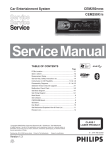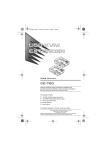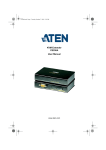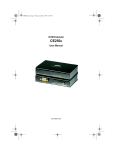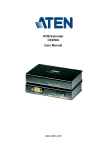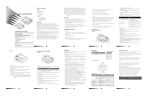Download ATEN CE-250 User manual
Transcript
CE250.fm Page 1 Thursday, March 29, 2007 1:43 PM AC C O N S O L I R AC CO NS O LE RE MO TE 9V E E M O T /O E 9V I /O User Manual CE-250 Read this guide thoroughly and follow the installation and operation procedures carefully in order to prevent any damage to the units and/or any devices that connect to them. This package contains: 1 CE-250L KVM Extender (Local Unit) 1 CE-250R KVM Extender (Remote Unit) 1 CS Custom KVM Cable 2 Power Adapters 1 User Manual If anything is damaged or missing, contact your dealer. Copyright © 2006 ATEN® International Co., Ltd. Manual Part No. PAPE-1221-100 Printing Date: 03/2007 ATEN and the ATEN logo are trademarks of ATEN International Co., Ltd. All rights reserved. All other trademarks are the property of their respective owners. CE250.fm Page 2 Thursday, March 29, 2007 1:43 PM Note: This equipment has been tested and found to comply with the limits for a Class B digital device, pursuant to Part 15 of the FCC Rules. These limits are designed to provide reasonable protection against harmful interference in a residential installation. This equipment generates, uses and can radiate radio frequency energy, and if not installed and used in accordance with the instruction manual, may cause interference to radio communications. However, there is no guarantee that interference will not occur in a particular installation. If this equipment does cause harmful interference to radio or television reception, which can be determined by turning the equipment off and on, the user is encouraged to try to correct the interference by one or more of the following measures: Reorient or relocate the receiving antenna; Increase the separation between the equipment and receiver; Connect the equipment into an outlet on a circuit different from that which the receiver is connected; Consult the dealer or an experienced radio/television technician for help. CE250.fm Page 3 Thursday, March 29, 2007 1:43 PM Overview Because the CE-250 KVM Extender System allows access to a computer system from a remote console (keyboard, monitor, and mouse), it is perfect for factory and construction sites, or any type of installation where the console needs to be in a conveniently accessible location, but you want the system equipment to reside in a safe place - away from dust, dirt, and harsh environmental influences. The CE-250 System is also useful for control and security purposes, where you can have the system unit in a secure area at the same time that you put the console in a location that offers convenient access. The CE-250 KVM Extender provides the ideal means to access the remote system box, since it improves on previous designs by using inexpensive Category 5 cable - the kind commonly used in Ethernet networks - instead of bulkier, more expensive, standard cables. Category 5 cabling makes for a much neater, more convenient, more reliable data transfer connection. The CE-250 features a custom ASIC to ensure the utmost in reliability and compatibility, and can also sense the distance to the system and automatically adjust the gain to compensate. Setup is as easy as can be - simply connect the computer system box and local console to the Local CE-250 Module; run the Cat. 5 cable to the Remote CE-250 Module (up to 150 meters away); and plug the remote console into the Remote Module. Note: You can control numerous remote systems from a single console by combining the CE-250 with a KVM switch. -3- CE250.fm Page 4 Thursday, March 29, 2007 1:43 PM Features Built-in ASIC for greater reliability and compatibility Cat 5 cable to connect the local and remote units – up to 150 meters apart Dual console operation – control your system from both the local and remote PS/2 keyboard, monitor, and mouse consoles Push button selection – of the active console High resolution video – up to 1280 x 1024 Supports VGA, SVGA, and multisync monitors Local monitor supports DDC; DDC2; DDC2B Automatic gain control – automatically adjusts signal strength to compensate for distance Easy to install – no software required – connecting cables to the devices is all it takes -4- CE250.fm Page 5 Thursday, March 29, 2007 1:43 PM System Requirements Consoles A VGA, SVGA, or Multisync monitor capable of the highest resolution that you will be using on any computer in the installation A PS/2 style keyboard A PS/2 style mouse Note: 1. If you connect a DDC type monitor to the Local Unit, the monitor that connects to the Remote Unit must be able to support the highest video resolution that the DDC monitor can provide. 2. You must use the same brand and model of mouse on both the local and remote units. Computers The following equipment must be installed on each computer that is to be connected to the system: A VGA, SVGA, or Multisync card A 6-pin mini-DIN mouse port A 6-pin mini-DIN Keyboard port Cables Although it is possible to use standard KVM cables to link computers to the CE-250L, for optimal signal integrity, and to simplify the layout, we strongly recommend that you use the high quality CS Custom KVM Cable that is provided with this package. Category 5 cable is the minimum required to connect the local and remote CE-250 units. Cable of a lesser standard will result in degrading the video signal. For best performance, we strongly recommend Category 5 cable. -5- CE250.fm Page 6 Thursday, March 29, 2007 1:43 PM Components The Local Unit (CE-250L) Front View: 2 1 AC C O N S O L I 3 9V E R E M O T /O E 4 7 5 # Description 1 Operating Mode Selection Switch 6 Function Pressing this button toggles between the operating mode choices: Local: only the local console can control the system(s) Auto: both consoles can control the system(s). 2 LEDs The Local Unit has two LEDs to indicate the operating status of the Local and Remote units (see CE-250L (Local Unit), p. 11). 3 Mouse Port The local PS/2 mouse plugs into this connector. 4 Keyboard Port The local PS/2 keyboard plugs into this connector. 5 Monitor Port The local monitor plugs into this connector. 6 Remote I/O The Cat 5 twisted pair cable that connects to the Remote Unit plugs into this connector. 7 Power Jack The cable from the AC Power Adapter plugs into this jack. -6- CE250.fm Page 7 Thursday, March 29, 2007 1:43 PM The Local Unit (CE-250L) Rear View: C P U 1 2 # 3 Description Function 1 Monitor Port The HDB-15 Video connector of the KVM cable that connects to the computer's Video port plugs into this connector. 2 Keyboard Port The Keyboard connector of the KVM cable that connects to the computer's Keyboard port plugs into this connector. 3 Mouse Port The Mouse connector of the KVM cable that connects to the computer's Mouse port plugs into this connector. Note: If you are combining the CE-250 with a KVM switch, the KVM cable connects back to the respective ports on the Console section of the switch. -7- CE250.fm Page 8 Thursday, March 29, 2007 1:43 PM The Remote Unit (CE-250R) Front View: 1 AC CO 2 NS O LE RE TE 9V I /O 3 6 4 # MO 5 Description Function 1 LEDs The Remote Unit has two LEDs (Power and On Line) to indicate the operating status of the Local and Remote units (see CE-250R (Remote Unit), p. 11). 2 Mouse Port The remote PS/2 mouse plugs into this connector. 3 Keyboard Port The remote PS/2 keyboard plugs into this connector. 4 Monitor Port The remote monitor plugs into this connector. 5 Remote I/O The Cat 5 twisted pair cable that connects back to the Local Unit plugs into this connector. 6 Power Jack The cable from the AC Power Adapter plugs into this jack. -8- CE250.fm Page 9 Thursday, March 29, 2007 1:43 PM Installation Setting up the CE-250 KVM Extender system is simply a matter of plugging in the cables. Refer to the installation diagram on the following page and do the following: 1. Make sure that all the equipment to be connected up is powered Off. 2. Plug the cables from the local console devices (mouse, keyboard, monitor), into their ports on the Console side of the Local Unit (CE-250L). 3. Plug the appropriate connectors on the KVM cable supplied with this unit into the CPU side of the CE-250L. Each connector is marked with an appropriate icon to indicate which it is. Note: The female monitor connector is the one that plugs into the CE-250L. 4. Plug the connectors on the other end of the cable into the appropriate ports on the computer (or Console section of the KVM switch - if you are using one). Each connector is marked with an appropriate icon to indicate which it is. 5. Plug either end of the Category 5 twisted pair cable into the CE-250L's Remote I/O port. 6. Plug one of the power adapters (supplied with this package) into an AC source; plug the adapter's power cable into the CE-250L's Power Jack 7. Plug the other end of the Category 5 twisted pair cable into the I/O port of the Remote Unit (CE-250R). 8. Plug the cables from the remote console devices (mouse, keyboard, monitor), into their ports on the Console side of the CE-250R. 9. Plug the second power adapter (supplied with this package) into an AC source; plug the adapter's power cable into the CE-250R's Power Jack. -9- CE250.fm Page 10 Thursday, March 29, 2007 1:43 PM CE-250L FrontView AC C O N S O L E I R C P E M O T /O E U CE-250L Rear View CE-250R AC CO NS O LE RE - 10 - MO TE I /O 9V 9V CE250.fm Page 11 Thursday, March 29, 2007 1:43 PM Operation The Local and Remote Units each have two LEDs to indicate their operating status, as shown in the tables, below: CE-250L (Local Unit) Operating Mode LED Local Local Lights to indicate that the local console is active (the Remote LED is out). Remote The LED is Off Auto 1. Lights when the local console is active (the Remote LED is out). 2. Turns off when the remote console is active (the Remote LED turns on). 3. Flashes on and off alternately with the Remote LED when neither console is active. 1. Lights when the remote console is active (the Local LED is out). 2. Turns off when the local console is active (the Local LED turns on). 3. Flashes on and off alternately with the Local LED when neither console is active. CE-250R (Remote Unit) LED Power Indication 1. Lights steadily to indicate that the connection to the Local Unit is ok. 2. Flashes when there is a problem with the connection to the Local Unit. On Line 1. Lights when the remote console is active. 2. Is Off when the local console is active. 3. Is Off when there is a problem with the connection to the Local Unit. - 11 - CE250.fm Page 12 Thursday, March 29, 2007 1:43 PM Troubleshooting Problem Action No video Make sure that all cables are securely plugged into their sockets. Poor video quality. The video quality can be improved by reducing the refresh rate. TP Wiring Diagram PAIR 3 PAIR 2 PAIR 1 PAIR 4 1 2 3 4 5 6 7 8 W-O O W-G Bl W-Bl G W-Br Br JACK POSITIONS T568B AT&T 258A TP Pin Assignments Pin Assignment 1 V OUT B 2 /V OUT B 3 V OUT G 4 V OUT R 5 /V OUT R 6 /V OUT G 7 /DO 8 DO - 12 - CE250.fm Page 13 Thursday, March 29, 2007 1:43 PM Specifications Function Connectors CE-250L CE-250R Keyboard 2 x 6-pin Mini-DIN F 1 x 6-pin Mini-DIN F Mouse 2 x 6-pin Mini-DIN F 1 x 6-pin Mini-DIN F Monitor 1 x HDB-15 M 1 x HDB-15 F 1 x HDB-15 F LEDs Function Keys 1 x Local 1 x Power On 1 x Remote 1 x On Line 1 x Local/Auto Select N/A Cable Length Video Resolution Power Consumption 150m [500'] (max.) 1280 x 1024; DDC; DDC2; DDC2B AC 9V, 2.7W (max.) Housing Weight Dimensions (L x W x H) AC 9V, 4.0W (max.) Plastic 0.30kg 0.22kg 13 x 10 x 3.5 cm 10 x 8 x 3.5 cm * DDC, DDC2, and DDC2B support is for the Local monitor only. - 13 - CE250.fm Page 14 Thursday, March 29, 2007 1:43 PM Limited Warranty IN NO EVENT SHALL THE DIRECT VENDOR'S LIABILITY EXCEED THE PRICE PAID FOR THE PRODUCT FROM THE DIRECT, INDIRECT, SPECIAL, INCIDENTAL OR CONSEQUENTIAL DAMAGES RESULTING FROM THE USE OF THE PRODUCT, DISK OR ITS DOCUMENTATION. The direct vendor makes no warranty or representation, expressed, implied, or statutory with respect to the contents or use of this documentation, and specially disclaims its quality, performance, merchantability, or fitness for any particular purpose. The direct vendor also reserves the right to revise or update the device or documentation without obligation to notify any individual or entity of such revisions, or update. For further inquires please contact your direct vendor. - 14 -















